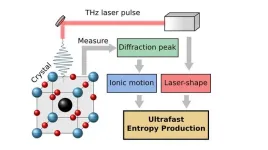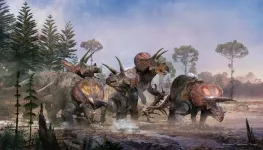(Press-News.org) Entropy, the amount of molecular disorder, is produced in several systems but cannot be measured directly. An equation developed by researchers at Chalmers University of Technology and Heinrich Heine University Düsseldorf, now sheds new light on how entropy is produced on a very short time scale in laser excited materials.
“New computational models give us new research opportunities. Extending thermodynamics for ultrashort excitations will provide novel insights into how materials function on the nanoscale,” says Matthias Geilhufe, Assistant Professor at the Department of Physics at Chalmers University of Technology.
Entropy is a measure of irreversibility and disorder and is central in thermodynamics. Two centuries ago, it was part of a conceptual breakthrough, building the theoretical framework for machines, fundamental for the industrial revolution. Today, we are seeing advances in new areas of nano and quantum devices, but still, entropy is a pivotal concept.
“A system usually wants to evolve to a state with large disorder, i.e. maximum entropy. It can be compared to a sugar cube dissolving in a glass. While the sugar dissolves, the system composed of water and sugar slowly increases its entropy. The reverse process – a spontaneous formation of a sugar cube – is never observed,” says Matthias Geilhufe.
A computational model for entropy
“If we turn to how entropy is formed in devices, they all need to be turned on and off, or need to move something from A to B. As a consequence, entropy is produced. In some cases, we would like to minimize the entropy production, for example to avoid information loss,” says Matthias Geilhufe.
While entropy has become a well-established concept, it cannot be measured directly. However, Matthias Geilhufe together with researchers Lorenzo Caprini and Hartmut Löwen at Heinrich Heine University Düsseldorf, have developed a computational model to measure entropy production on a very short time scale in laser excited crystalline materials. Their research was recently published in an article in Nature Communications.
Phonons in crystalline materials can produce entropy
Crystalline materials are essential for various technologies that transfer and store information over short periods, such as semiconductors in computers or magnetic storage spaces. These materials are made up of a regular crystalline lattice, whereby atoms arrange in repeating patterns. Laser light can shake the atoms into a collective motion which physicists call phonons. Astonishingly, phonons often behave as if they were a particle. They are called quasiparticles, to distinguish them from actual particles like electrons or ions.
What the researchers have now discovered, is that the phonons – the lattice vibrations in the crystalline materials – can produce entropy in the same way as bacteria in water as shown by previous research in biological physics by Caprini and Löwen. By the very nature of the phonon being a quasiparticle in a crystal it can be shown that the same mathematical pattern holds as for their biological counterparts in water. This insight precisely determines the entropy and heat production in laser excited materials and allows us to understand or even change their properties on demand.
New perspectives on ultrafast materials
The researchers’ computational model can also be applied to other types of material excitations and thus opens a new perspective in the field of research on ultrafast materials.
“In the long run, this knowledge can be useful for tailoring future technologies, or lead to new scientific findings,” says Matthias Geilhufe.
More about the research:
The scientific article Ultrafast entropy production in pump-probe experiments was published in Nature Communications on January 2, 2024. It is written by R. Matthias Geilhufe, Chalmers University of Technology, and Lorenzo Caprini and Hartmut Löwen, Heinrich Heine University Düsseldorf. Lorenzo Caprini is currently active at University of Rome La Sapienza.
NOTE TO THE EDITOR - IMAGES:
All images for this press release can be downloaded from Cision.
The Chalmers Press portal can be accessed here and you can search for any images or videos.
We kindly request credit to be given in the following format where possible:
Image/Graphic/Illustration: Chalmers University of Technology | Name Surname
Images provided in Chalmers University of Technology press releases are, unless specified otherwise, free for download and publication as long as credit is given to the University and the individual creator. Cropping and rescaling of the images is permitted when required for adaptation to the publication’s format, but modifications that would influence the message and content of the original are not. The material is primarily intended for journalistic and informative use, to assist in communication and coverage of Chalmers’ research and education. Commercial usage, for example the marketing of goods and services, is not permitted.
For more information, please contact:
Matthias Geilhufe, Assistant Professor, Department of Physics, Chalmers University of Technology, matthias.geilhufe@chalmers.se
Hartmut Löwen, Professor, Institut für Theoretische Physik II: Soft Matter, Heinrich-Heine University Düsseldorf, hlowen@hhu.de , +49 211 81 11377
Lorenzo Caprini, Assistant Professor, Physics Department, University of Rome La Sapienza, lorenzo.caprini@uniroma1.it
The contact persons speak English, German, Swedish and Italian, and are available for live and pre-recorded interviews. At Chalmers, we have podcast studios and broadcast filming equipment on site and would be able to assist a request for a television, radio or podcast interview.
END
New method to measure entropy production on the nanoscale
2024-03-26
ELSE PRESS RELEASES FROM THIS DATE:
Scientists on the hunt for evidence of quantum gravity’s existence at the South Pole
2024-03-26
Scientists on the hunt for evidence of quantum gravity’s existence at the South Pole
University of Copenhagen team contributes to an Antarctic large-scale experiment striving to find out if gravity also exists at the quantum level. An extraordinary particle able to travel undisturbed through space seems to hold the answer.
Several thousand sensors distributed over a square kilometer near the South Pole are tasked with answering one of the large outstanding questions in physics: does quantum gravity exist? ...
New roadmap to prevent pandemics centers on protecting biodiversity
2024-03-26
ITHACA, N.Y. – An international team of 25 scientists has proposed a roadmap for how to prevent the next pandemic by conserving natural areas and promoting biodiversity, thereby providing animals with enough food, safe havens and distance to limit contact and the transfer of pathogens to humans.
Pandemics begin when disease-harboring animals, such as bats, come in close proximity with people, livestock or other animals and pass on new pathogens. Viruses such as SARS-CoV-2, SARS-CoV-1, Nipah, Hendra and possibly Ebola have all fatally spilled over from bats to humans, ...
New maps help decision-makers factor albedo into tree-planting decisions
2024-03-26
Arlington, VA – As efforts to restore tree cover accelerate to help avoid runaway climate change, a new study highlights how restoring tree cover can, in some locations, heat up the Earth rather than cool it by affecting how much sunlight the surface reflects (i.e. “the albedo").
This new study by researchers at Clark University in the United States alongside scientists from The Nature Conservancy (TNC) and ETH-Zurich, published today in the journal Nature Communications, provides a global analysis of where restoration of tree cover is most effective at cooling the global climate system, considering ...
The construction of visual attention highlighted at the neuronal level
2024-03-26
In a world inundated with a constant stream of new information—notifications, ads, emails, news—we often struggle to prevent our attention from being constantly hijacked by external events. But is it truly within our power to filter and select our perceptions? And why do we find ourselves so easily distracted?
“Exogenous attention, the cognitive process that allows a salient visual stimulus to impose itself on us, is automatic. When a colleague walks past our desk, our attention is diverted from our computer screen despite ourselves,” explains Tal Seidel Malkinson (University of Lorraine), ...
Spielberg was right: Triceratops teamed up
2024-03-26
Actually, the team from Naturalis Biodiversity Center in the Netherlands was looking for a Tyrannosaurus, that summer of 2013 in Wyoming. Instead, they found a Triceratops: the famous dinosaur with the three horns and the large neck frill. And then they found another one. And another one. And more. The dig turned into a project that would last for more than ten years.
All in all, they dug up 1200 bones and bone fragments, of at least five individuals. A team of professional and volunteer paleontologists ...
Young adults with migraine, other nontraditional risk factors may have higher stroke risk
2024-03-26
Research Highlights:
Nontraditional risk factors for stroke were significantly associated with the development of strokes in adults younger than ages 35 to 45.
Migraine was the most important nontraditional risk factor for stroke among both men and women, according to the study of adults in Colorado.
Embargoed until 4 a.m. CT/5 a.m. ET Tuesday, March 26, 2024
DALLAS, March 26, 2024 — Adults younger than 35- to 45-years old may have a higher risk of developing a stroke from nontraditional risk factors ...
New data offer reality check on blood-based colorectal cancer screening
2024-03-26
Bethesda, MD (March 26, 2024) – Modeling studies and expert consensus published today in the journals Gastroenterology and Clinical Gastroenterology and Hepatology shed new light on the promise and peril of liquid biopsy (blood tests) for colorectal cancer (CRC) screening that are currently in development.
“Based on their current characteristics, blood tests should not be recommended to replace established colorectal cancer screening tests, since blood tests are neither as effective or cost-effective, ...
Virginia Tech study considers ways to increase accessibility for all wildlife enthusiasts
2024-03-26
One in three birders experiences accessibility challenges to participation in birding, according to Virginia Tech researchers Emily Sinkular and Ashley Dayer.
“I like to think of our research as blending together two previously unconnected fields: disability studies and wildlife recreation,” said Sinkular, a Ph.D. student and lead author of the study published March 26 in the journal Human Dimensions and Wildlife. “There’s been quite a lot of research on disability and lots of research on birding, but very few researchers have combined these two topics together.”
The ...
From autism to Alzheimer’s: A large-scale animal study links brain pH changes to wide-ranging cognitive issues
2024-03-26
A global collaborative research group comprising 131 researchers from 105 laboratories across seven countries announces a groundbreaking research paper submitted to eLife. Titled "Large-scale Animal Model Study Uncovers Altered Brain pH and Lactate Levels as a Transdiagnostic Endophenotype of Neuropsychiatric Disorders Involving Cognitive Impairment," the study identifies brain energy metabolism dysfunction leading to altered pH and lactate levels as common hallmarks in numerous animal models of neuropsychiatric and neurodegenerative disorders, such as intellectual disability, autism spectrum disorders, schizophrenia, bipolar disorder, depressive disorders, and Alzheimer’s ...
Tiniest ‘starquake’ ever detected – new study
2024-03-26
An orange dwarf star has yielded the tiniest ‘starquakes’ ever recorded, measured by an international team of scientists.
Named Epsilon Indi, the star is the smallest and coolest dwarf star yet observed with solar-like oscillations – “starquakes” like those shown by the Sun. These oscillations provide indirect glimpses of stellar interiors – just as earthquakes tell us about Earth's interior – and so are important sources of information about the makeup of the star.
The measurements ...




